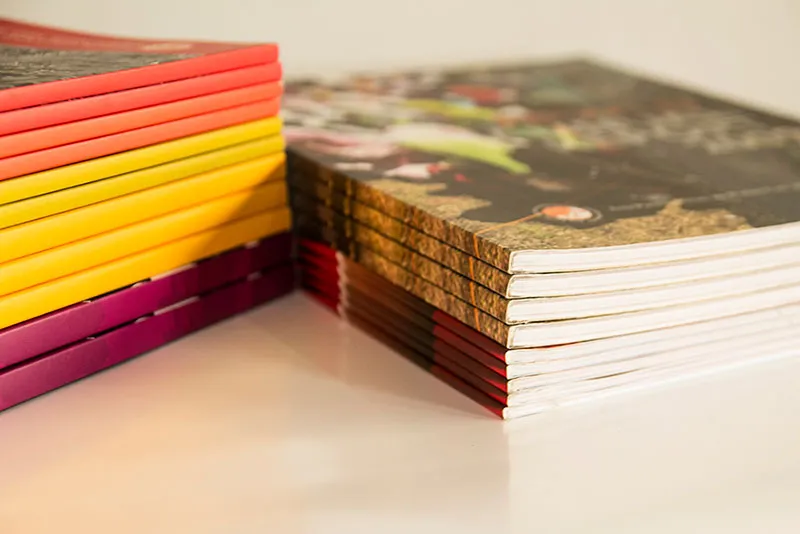Softcover book printing refers to the process of printing books using soft materials for the cover, such as paper or cardstock, as opposed to hardcover books which use hard materials like cardboard or leather. Softcover books are also known as “paperbacks” or “trade paperbacks.” They are generally less expensive to produce than hardcover books and are more popular for mass-market or commercial publications. The printing process for softcover books involves offset printing presses, digital printing presses, or both, depending on the quantity and specifications of the book.
Benefits of softcover book printing
There are several benefits to using softcover book printing, including:
Cost-effective
Softcover books are less expensive to produce than hardcover books because the materials used for the cover are less costly. The cover paper is thinner and less stiff than the cover board used for hardcovers, and the spine can be glued rather than sewn, which reduces labor costs. Additionally, softcover books are more space-efficient to store, which can help reduce costs for publishers and retailers. Because of these cost savings, softcover books are often priced lower than hardcover books, making them more affordable for consumers.
Portable
Softcover books are lightweight and easy to carry. They are generally smaller in size and can be easily slipped into a bag or purse, making them perfect for reading on the go, whether it be on a train, bus, or plane, or while waiting in line or for an appointment. They are also more flexible, so they can be comfortably held in one hand, which is a great option for people who commute, travel, or read in bed. Besides, the soft cover makes them more flexible and resistant to damage, making them more suitable for traveling with you.
Flexible
Softcover books can be printed in various sizes and formats, making them more versatile than hardcover books. Softcover books can be produced in standard trade size, mass market, digest, and even larger formats. This flexibility allows publishers to target a wider range of genres and audiences, such as children’s books, cookbooks, and travel guides, printed in a smaller format, or academic and reference books that can be printed in a larger format. Softcover books can be printed in different shapes and sizes, making them ideal for various publications, such as graphic novels and art books.
Durable
Modern softcover book printing uses high-quality papers and inks that are resistant to wear and tear, which ensures that the books will last for a long time. The cover paper used for softcover books is now often glossy and thicker than it used to be, which makes them more durable and resistant to damage. Additionally, the inks used for printing are also of high quality, which means that the images and text on the page will not fade or smudge easily. The use of high-quality materials and advances in printing technology have greatly increased the durability of softcover books, making them a great option for personal and institutional use.
Environmental friendly
Softcover books are made of paper which is a more sustainable and environmentally friendly option than hardcover books made of plastic or other non-biodegradable materials. Paper is a renewable resource and can be recycled, whereas many other materials, such as plastic, are not biodegradable and can have a negative impact on the environment if not disposed of properly. Additionally, the use of paper in book production is relatively low-impact compared to other materials, and the process of recycling paper produces fewer emissions and uses less energy than the process of manufacturing new paper. As a result, softcover books are considered a more eco-friendly option than hardcover books and can be part of a sustainable reading culture.
Short-run printing
Softcover books can be printed on-demand using digital printing technology, meaning the book is only printed when an order is placed. This eliminates the need for a large initial print run and reduces the risk of overprinting and waste. This type of printing is also cost-effective as it eliminates the need for warehousing and shipping large quantities of books and allows for easy personalization and customization of books. Additionally, it allows for faster turnaround times, which is especially beneficial for authors and publishers who want to bring their books to market quickly. Basically, on-demand printing can help keep costs low for both authors and publishers, and it can also reduce the environmental impact of traditional offset printing.
Binding
Softcover books are typically glued rather than sewn, which reduces the cost and increases the speed of the production process. The process of gluing the pages of a softcover book together is called perfect binding. In this process, the pages are cut to size, glued together at the spine, and then glued to the cover. This binding method is less time-consuming and requires less labor than sewn binding, which is used for hardcover books, making it less expensive. Besides, the perfect binding allows for a wide range of paper thicknesses and types, which makes it more versatile and suitable for a wide range of genres and audiences.
Customizable covers
Softcover books can have customizable covers, allowing authors, publishers, and readers to personalize their books with images, text, and designs of their own choosing. This feature is particularly useful for self-publishing authors, small presses, and niche market publishers who want to create a unique and eye-catching cover that stands out in a crowded marketplace. Customizable covers can be achieved through digital printing technology, which allows for the use of high-resolution images and graphics and the ability to print in full color. Additionally, it allows for using different coatings, such as gloss or matte, which can add texture and depth to the cover design. The cover design can also be adjusted to match the book’s target audience and genre, attracting more readers and increasing the chances of selling more books.
Print Quality
Softcover books can be printed using digital or offset printing technology, allowing high-quality images and text. Digital printing technology uses toner or inkjet printing to produce high-quality images and text, allowing for on-demand, cost-effective, and efficient printing. On the other hand, offset printing uses a metal plate to transfer ink onto the paper. It can handle larger print runs and is better suited for printing large quantities of books. Offset printing is often used for printing softcover books in large quantities. Both digital and offset printing can produce high-quality images and text. However, the choice of technology will depend on the print run size, the need for customization, and the desired outcome.





